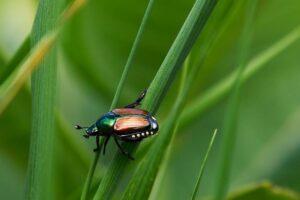Hungary is also threatened by the appearance of the Japanese beetle, which is native to Asia, as a closed-end pest
The Japanese beetle (Popillia japonica), native to Asia, may also appear in our country. The closed-loop pest is already present in neighboring Slovenia. It can cause enormous damage, especially in agriculture, so it is of utmost importance that farmers only obtain propagating material and plants from reliable sources for planting, and avoid soil of unknown origin as a growing medium.

(Photo: Pixabay)
In Europe, the Japanese beetle (Popillia japonica) appeared for the first time in Northern Italy in 2014 as a closed-door pest, and its population gradually increased and spread throughout Italy. Three years later, experts from the local authority detected the pest on the southern border of Switzerland, and then it spread further and was also detected on the northern border of the country. Nowadays, its presence has already been confirmed in Portugal, Slovenia and Germany, as well as in Russia outside the EU. Fortunately, the Japanese exchange beetle has not yet occurred in Hungary, but a few mature specimens have already been found in neighboring Slovenia this year. The risk is increased by the fact that the pest can fly up to 10 kilometers in a short time, and it spreads and reproduces quickly, as it can lay 40-60 eggs in one season during its migration.
The swarming period and mass appearance of the Japanese beetle lasts from mid-May to the end of August
The adult beetle can also cause economic damage by attacking leaves, flowers and fruits. However, the main pest is the weevil, i.e. the larva, which mainly chews the roots of grasses, and its presence attracts wild animals in search of food, such as wild boar. Because of the above, it is therefore crucial to carry out preventive measures. Nébih advises both hobby gardeners and professional farmers to only buy propagating material and plants intended for planting from safe places, and also not to bring soil of unknown origin with them during their travels.
The Japanese beetle has a very diverse diet, more than 400 different host plants are known
This includes grapes, corn, stone fruits, berry fruits, soybeans, as well as many ornamental trees and plants, such as roses, purple acacia, and medicinal cypress. The pest has already been observed on wild plants in its main area of infection, in Italy (including Rubus, Ulmus, Urtica, Rosa, Populus, Parthenocissus species).
Nébih
Related news
Safe vegetable fermentation
🎧 Hallgasd a cikket: Lejátszás Szünet Folytatás Leállítás Nyelv: Auto…
Read more >Some of SIRHA’s partners
🎧 Hallgasd a cikket: Lejátszás Szünet Folytatás Leállítás Nyelv: Auto…
Read more >Nébih suspends the operations of a confectionery manufacturer
🎧 Hallgasd a cikket: Lejátszás Szünet Folytatás Leállítás Nyelv: Auto…
Read more >Related news
Best Global Brands: the most valuable brands in 2025
🎧 Hallgasd a cikket: Lejátszás Szünet Folytatás Leállítás Nyelv: Auto…
Read more >Tariffs, protection and pipe dreams
🎧 Hallgasd a cikket: Lejátszás Szünet Folytatás Leállítás Nyelv: Auto…
Read more >Trade magazin projects at the SIRHA Budapest 2026 trade show
🎧 Hallgasd a cikket: Lejátszás Szünet Folytatás Leállítás Nyelv: Auto…
Read more >






